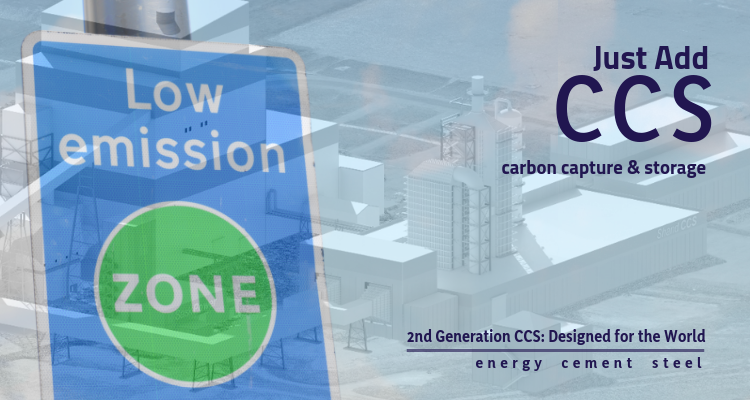Carbon Capture and Storage (CCS) takes carbon dioxide (CO2) emissions, stops them from entering the atmosphere and locks them safely underground. It’s a powerful tool in the race towards net-zero, helping industries like power plants and factories reduce their greenhouse gas emissions while continuing to produce the products we need.
How Does CCS Work?
CCS is a three-step process that transforms CO2 into a manageable compressed state and stores it permanently underground.
Path of CO2 Through the Amine-Based Capture Process
Flue gas containing about 3-22% CO2 is diverted from the flue gas stack to the CO2 Capture System.
Flue gas containing CO2 is pre-treated to the conditions appropriate for CO2 capture.
The flue gas is then sent to a large vessel called an absorber. To increase the contact between solvent and flue gas the absorber is filled with layers of structured metal packing that is continuous to the sides of the unit (like a metal sponge).
A chemical solvent (called amine) that targets CO2 gas, is showered into the vessel.
As the flue gas rises, the amine reacts with the CO2, absorbing the gas into its solvent before accumulating in the bottom of the vessel. At this point the amine solution is referred to as “rich amine”.
The amine containing CO2 is then showered into a stripper, which is a vessel that heats the solvent to release the CO2 back into a gas.
The amine that is stripped of CO2 (referred to as “lean” amine) is recycled back into the absorber to repeat the process and capture more CO2.
The CO2 gas is sent to a compressor and dehydration unit where it is compressed into a liquid, dense phase, or supercritical state.
These large volumes of compressed CO2 are transported by pipeline, truck, or ship to be permanently stored or used in enhanced oil recovery (EOR).
(Cement/Natural Gas/Steel/Coal Power)
Diverter Damper
Flue Gas
Pre-Treated Flue Gas
Treated flue gas (primarily contains nitrogen, water vapor, trace elements with less than 2% CO2)
Heat Exchanger
Rich Amine
Lean Amine
Lean Amine
Rich Amine
Heat
(externally sourced)
Pure CO2
(contains water)
Compressed CO2
Enhanced Oil Recovery (EOR)
Stored
Capture
The first step is capturing CO2 from industrial facilities, like coal and natural gas power plants or steel mills. This involves separating CO2 from other gases produced during power generation or manufacturing processes.
Transport
After the CO2 is captured, it’s compressed into a dense, liquid-like state. This makes it easier to transport through pipelines to a storage site. In some cases, ships, trucks, or trains can also be used, especially for smaller amounts.
Storage
The final step is safely storing the CO2 deep underground. There are two main methods:
- Permanent Storage: CO2 is injected into a suitable geological formation, where it is securely stored.
- Enhanced Oil Recovery (EOR): CO2 is injected into depleted oil fields to help extract more oil, and then it remains stored underground in the reservoir.
Carbon Capture and Storage at a Glance
Source of carbon dioxide (CO2) emissions from industrial or energy plants. With carbon capture and storage (CCS), large amounts of CO2 will be captured, recycled, and permanently stored.
Flue gas is captured and CO2 is separated into a liquid, dense or supercritical phase for transportation and storage.
CO2 is transported by pipeline, truck, rail or ship depending on the infrastructure available.
The CO2 is sent deep underground for:
- Enhanced Oil Recovery (EOR) when CO2 is injected to produce oil. The CO2 is produced at the wellhead with the oil during production, recaptured and recycled and over time permanently stored safely in depleted oil and gas formations.
The CO2 is sent deep underground for:
- Permanent storage into porous rock formations, typically at depths exceeding 800M. Sites are carefully selected and evaluated to ensure the CO2 can be injected at the amounts required, that the formation has the capacity to store the CO2 and that the CO2 will be contained beneath impermeable caprock.
Measurement, Monitoring and Verification (MMV) activities are required before drilling a well, during injection and after a project is complete. MMV ensures the CO2 is behaving as expected.
CCS Facility
Cement
Steel
Natural Gas
Coal Power
CO2 injected for EOR
CO2 injected for deep permanent storage
Rigorous monitoring, measurement & verification
Drinking water
Impermeable formation
Impermeable formation
Deep oil/gas formation
Caprock – Impermeable formation is one of several barriers locking in CO2 permanently
Deep and dense sandstone formation with microscopic space
- The deep sandstone formation has microscopic spaces between its individual sand grains, or porosity, which allows it to hold high salinity water – that is 10 times more salty than the ocean. Due to the presence of this very salty brine, geologists refer to this type of formation as saline aquifer.
What is CCUS?
CCUS stands for Carbon Capture Utilization and Storage. Unlike CCS, which solely focuses on storage, CCUS also finds innovative uses for CO2. Though CCS and CCUS are often terms used interchangeably, CCUS highlights the potential of repurposing CO2 for various other applications.
Emerging forms of CO2 utilization are on the rise, for instance, CO2 can enhance the strength of products like cement! However, these applications use relatively small amounts of CO2 and won’t achieve our net-zero goals quickly enough. In contrast, EOR utilizes CO2 on a large scale, significantly reducing CO2 volumes while permanently storing it underground, offering a dual benefit.
Equivalent to removing 4.7 million cars from the road!
Equivalent to planting 2.6 billion trees on earth!
Canada’s Carbon Scorecard
To date, Canada has been a leader in the first generation of global CCS development, with five of the 30 commercial CCS projects in the world.
*Data collected as of May 31, 2025



